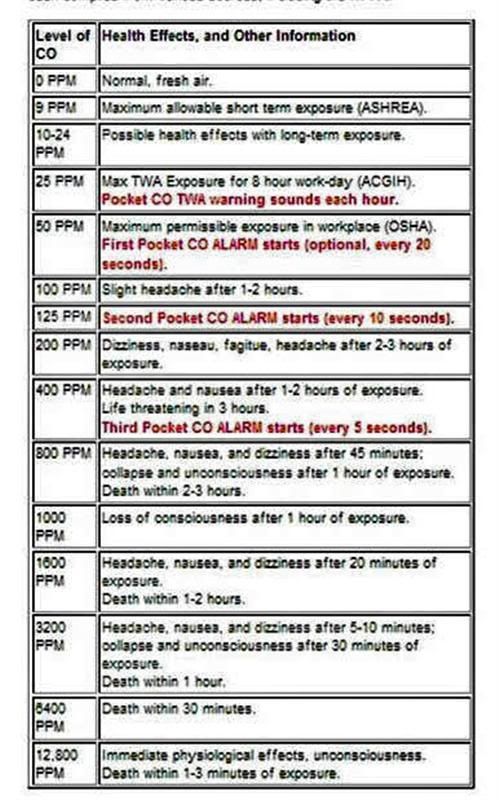- Messages
- 54,486
- Reaction score
- 8,588
- # of dives
- 500 - 999
My previous thread about this failed as that model was no longer available, and would cost twice as much as this one if again produced. For the record, I am not receiving any commissions or other benefits on the sale of these; I just think it is an affordable idea whose time has come...
I just got a phone call from the company who offers the CO monitor/tester I have decided on: Detect Carbon Monoxide with extensive information on the various pages there. Shipments are finally being started on the Model 300 with user replaceable batteries, 24/7 monitoring option - that I will certainly use at least on all trips, and can even be user calibrated. For tank testing, it will take a little longer than with Nitrox testers, as one must allow flow from a cracked tank for at least 2 minutes, or place the device in a plastic bag, expel all air, then fill partially from tank and tie closed, waiting at least 90 seconds. To avoid false alerts in other uses, it does not react to less than 5 ppm, but from there measures in 1 ppm to 500. If I get 5 ppm, I'd be hesitant; if I get 10 or more, I'd be looking for a new operator ASAP.
Who knows how many tropical scuba deaths are written off as "drowning" with the tank and body never being tested for CO? I'm sending this device with my local dive shop to Utila next week for my Tech Instructor to try out. To me, it seems like a prudent idea to any traveling diver, anywhere - more so in less developed destinations...
$139 plus shipping...

Excerpted from Alert Diver Article
CO Monitors - a carbon monoxide detector can save your life
May / June 1998 Issue, By: Robert N. Rossier
“Most states and municipalities do not require testing of a diver's air in the event of a fatality. The autopsy findings of a drowning victim are non-specific, and the presumed cause of death is often based on circumstantial evidence. Routine toxicological studies performed at autopsy do not include a measure of CO blood or tissue levels. Unless CO poisoning is suspected, usually no tests are made to determine levels in the body or the amount in the diver's breathing-gas cylinder. These facts point to the question of how many other diving fatalities might actually involve CO poisoning as a contributing factor.”
DAN members may login to see the entire article here: Divers Alert Network : Alert Diver Articles
For a possible dive to 130 ft, breathing almost at 5 ATA - more if the need for a great depth is needed for some reason, I think that a diver could view 10 ppm as the same as 50 on the chart below. Or, referring to Compress Gas Assn Grade E limits for scuba air: 10 ppm is the maximum allowed.…

I just got a phone call from the company who offers the CO monitor/tester I have decided on: Detect Carbon Monoxide with extensive information on the various pages there. Shipments are finally being started on the Model 300 with user replaceable batteries, 24/7 monitoring option - that I will certainly use at least on all trips, and can even be user calibrated. For tank testing, it will take a little longer than with Nitrox testers, as one must allow flow from a cracked tank for at least 2 minutes, or place the device in a plastic bag, expel all air, then fill partially from tank and tie closed, waiting at least 90 seconds. To avoid false alerts in other uses, it does not react to less than 5 ppm, but from there measures in 1 ppm to 500. If I get 5 ppm, I'd be hesitant; if I get 10 or more, I'd be looking for a new operator ASAP.
Who knows how many tropical scuba deaths are written off as "drowning" with the tank and body never being tested for CO? I'm sending this device with my local dive shop to Utila next week for my Tech Instructor to try out. To me, it seems like a prudent idea to any traveling diver, anywhere - more so in less developed destinations...
$139 plus shipping...

Excerpted from Alert Diver Article
CO Monitors - a carbon monoxide detector can save your life
May / June 1998 Issue, By: Robert N. Rossier
“Most states and municipalities do not require testing of a diver's air in the event of a fatality. The autopsy findings of a drowning victim are non-specific, and the presumed cause of death is often based on circumstantial evidence. Routine toxicological studies performed at autopsy do not include a measure of CO blood or tissue levels. Unless CO poisoning is suspected, usually no tests are made to determine levels in the body or the amount in the diver's breathing-gas cylinder. These facts point to the question of how many other diving fatalities might actually involve CO poisoning as a contributing factor.”
DAN members may login to see the entire article here: Divers Alert Network : Alert Diver Articles
For a possible dive to 130 ft, breathing almost at 5 ATA - more if the need for a great depth is needed for some reason, I think that a diver could view 10 ppm as the same as 50 on the chart below. Or, referring to Compress Gas Assn Grade E limits for scuba air: 10 ppm is the maximum allowed.…

Last edited:



